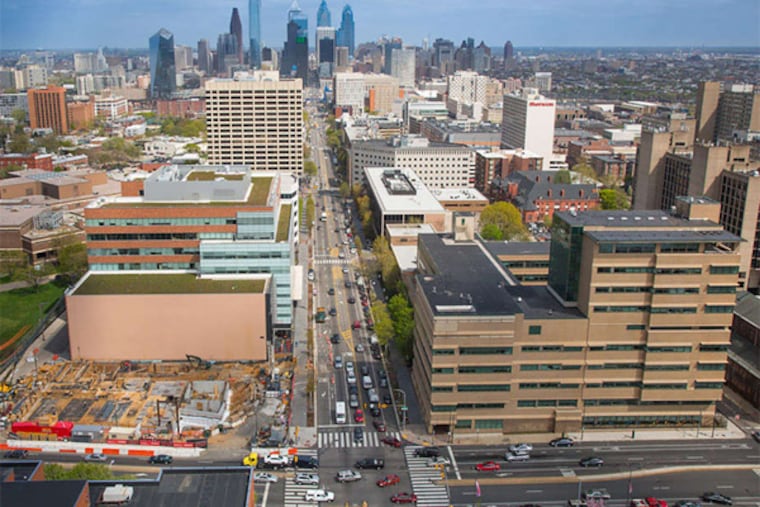University City Science Center going strong at 50
Charles Dilks, 72, thoroughly enjoyed the party at the Hotel Monaco, where he and 400 others toasted the University City Science Center on its 50th anniversary.

Charles Dilks, 72, thoroughly enjoyed the party at the Hotel Monaco, where he and 400 others toasted the University City Science Center on its 50th anniversary.
"We had a great time," he said.
That was Thursday.
In the mid-1960s, when Dilks was the second employee hired at the science center, it was an entirely different story.
"We were at the very edge of bankruptcy," said Dilks, who went from being an all-everything administrator to head of operations as the complex grew in stature and physically expanded. "I had many sleepless nights."
Lauded as the nation's first urban research park, the University City Science Center is one of the region's prime incubators of technical businesses, generating $9.4 billion in regional economic activity, according to one report.
Its QED program provides a way for professors to test their ideas for commercial viability. Its Quorum serves as a gathering place for entrepreneurs, investors, and advisers.
The center grew from one building to 15, with one underway and another on the drawing board, on an eight-acre campus that lines Market Street from 34th Street to just west of 38th.
Started with $500,000 contributed by a handful of area universities, it now has 31 partners and annual revenue of $22 million, mostly from rents paid by 100 health, science, and biotech companies.
The rents fund the center's core mission, housed in about 50,000 square feet: the incubation and development of job-generating companies, explained Stephen Tang, the center's chief executive.
"It was a deteriorating area . . . with a variety of low-rise buildings, mostly bars," said Dilks, recalling 1963.
The presidents of Temple, Drexel, and Penn decided Philadelphia needed something like the North Carolina Research Triangle Park, particularly since the city's manufacturing base was eroding. Local science companies said they would be tenants.
By the time the center opened, "all the [prospective tenants] had moved out of the city," Dilks said.
Besides that, neighbors were convinced, Dilks said, that this would be urban renewal, and they were going to be booted from their homes. Vietnam-era peace activists protested, worried that the center would focus on war-related research.
Eventually the center landed one tenant for 90 percent of 3401 Market St. Then the tenant left. "We were in a situation where we had negative-cash-flow problems," Dilks recalled.
But that crisis gave rise to the science center's current philosophy.
"We had to grow our own companies," Dilks said.
Invisible Sentinel Inc. is one of those companies.
"There's no other place like this around," said Benjamin Pascal on Thursday, hours before the celebration.
He and his partner, Nicholas Siciliano, had just hosted potential investors in a conference room available to Invisible Sentinel and the 30 other "port" or incubator companies housed on campus. Their guests were greeted by the shared receptionist.
In 2006, the partners developed a quick and cheap way to test foods for E. coli and other bacteria. In 2007, they moved into the center and are now about to graduate from their incubator-priced lab space to commercial quarters within the complex, tripling their square footage to 7,500 and doubling their current 18-employee staff.
In 2014, Pascal said, revenue, now "several hundred thousand," will top $2 million.
The center places a high premium on coincidental connections, and those served Pascal and Siciliano. They met two investors at a networking event hosted at the center.
Pascal said Invisible Sentinel was committed to Philadelphia. "I bought a home in Philly, and I'm here to stay," he said.
One of the University City Science Center's most famous graduates is Centacor Ortho Biotech Inc. Started in the center in 1979, it is now a major regional employer and maker of the much-prescribed drug Remicade, among others.
Michael Patterson hopes his company, Graphene Frontiers, gets to that point. His nanotech company has developed a way to mass-produce sheets of graphene, a strong, supple material that is just one atom thick, and with a multitude of potential uses.
Because the science center wrote a letter of support saying that Graphene had turnkey lab space in its facility, Graphene was able to get a key government grant.
"I believe that Philadelphia is the best place in the world to start a nanotechnology company," Patterson said.
215-854-2769
@JaneVonBergen